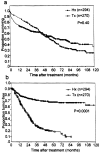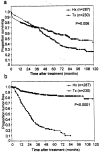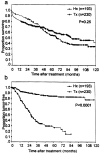Should hepatomas be treated with hepatic resection or transplantation?
- PMID: 10506698
- PMCID: PMC2974312
- DOI: 10.1002/(sici)1097-0142(19991001)86:7<1151::aid-cncr8>3.0.co;2-v
Should hepatomas be treated with hepatic resection or transplantation?
Abstract
Background: The aim of this collaborative study was to compare the long term results of hepatic resection (Hx) with those of orthotopic liver transplantation (OLTx) in large numbers of cirrhotic patients with hepatocellular carcinoma (HCC) and to delineate the roles of these two surgical treatments.
Methods: The databases of the National Cancer Center Hospital in Japan and the University of Pittsburgh Medical Center in the U. S. were exchanged and 294 cirrhotic patients who underwent curative Hx and 270 cirrhotic patients who underwent curative OLTx were selected for comparison.
Results: The mortality rate within 30 days and that within 150 days after Hx were significantly lower than those after OLTx (P = 0.001 and P = 0.00007, respectively). Overall survival was similar between the Hx group and the OLTx group (P = 0.40). When compared in the HCC patients without macroscopic vascular invasion and lymph node metastases, the overall survival rate after OLTx was significantly higher than that after Hx (P = 0.006). However, this difference was not significant between the patients with Child-Pugh Grade A tumors in the Hx group and all patients (majority with Child-Pugh Grade C tumors) in the OLTx group (P = 0.25). Tumor free survival after OLTx was significantly higher than that after Hx (P < 0.0001), particularly in HCCs measuring </=5 cm, unilobarly distributed tumors, and HCCs with either no or only microscopic vascular invasion. In HCCs measuring > 5 cm and those with macroscopic vascular invasion, the tumor free survival rate was similar between the Hx group and the OLTx group.
Conclusions: In the face of organ shortage, HCC developing in a well compensated cirrhotic liver initially may be treated with Hx. However, the authors believe OLTx should be applied selectively to those patients with tumor recurrence and/or progressive hepatic failure.
Copyright 1999 American Cancer Society.
Figures



References
-
- Yamada R, Sato M, Kawabata M, Nakatsuka H, Nakamura K, Takashima S. Hepatic artery embolization in 120 patients with unresectable hepatoma. Radiology. 1983;148:397–401. - PubMed
-
- Ebara M, Ohto M, Sugiura N, Okuda K, Kondo F, Kondo K. Percutaneous ethanol injection for the treatment of small hepatocellular carcinoma: study of 95 patients. J Gastroenterol Hepatol. 1990;5:616–26. - PubMed
-
- Shafir M, Shapiro R, Sung M, Warner R, Sicular A, Klipfel A. Cryoablation of unresectable malignant liver tumors. Am J Surg. 1996;171:27–31. - PubMed
-
- Sato M, Watanabe Y, Ueda S, Iseki S, Abe Y, Sato N, et al. Microwave coagulation therapy for hepatocellular carcinoma. Gastroenterology. 1996;110:1507–14. - PubMed
-
- Bismuth H, Houssin D, Ornowski I, Meriggi F. Liver resection in cirrhotic patients: a Western experience. World J Surg. 1986;10:311–7. - PubMed
Publication types
MeSH terms
Grants and funding
LinkOut - more resources
Full Text Sources
Medical
